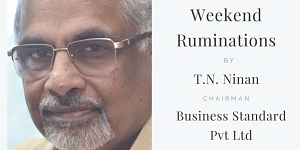The biggest potential benefit of this sector will be achieving more of Make in India.
Agriculture is crisis-ridden. Manufacturing is patchy when it comes to gaining momentum. Construction is down in the dumps, except for Nitin Gadkari’s highway programme. And the financial sector is affected by the banking crisis. So which is the sunrise sector? The surprising answer is trade, and more specifically organised retailing.
Consider recent developments. Reliance (mostly a B-to-B operation for much of its history) has just said its consumer-facing business is going to be the company’s growth driver. Walmart is investing $16 billion in Flipkart. And Ikea is about to open its first Indian store in Hyderabad. The stock market has caught the retail fever. The company that owns the D’Mart chain is quoting on the stock market at multiples of its public issue price last year, and commands a market capitalisation of close to a trillion rupees: Among the Top 30 in the country. This reflects global trends, with retail chains being prominent players and the creators of large personal fortunes in many countries.
 If the moves by the big boys in the business pay off in India, they could create ripples throughout the economy, with the development of better supply chains, volume production, integration into global commerce, and higher tax collection (no more farji bills!). The other development could be the coming together of online and main-street selling. As much has been outlined by Reliance Industries Chairman Mukesh Ambani and Ikea, and signalled by the Walmart investment in an online retailer.
If the moves by the big boys in the business pay off in India, they could create ripples throughout the economy, with the development of better supply chains, volume production, integration into global commerce, and higher tax collection (no more farji bills!). The other development could be the coming together of online and main-street selling. As much has been outlined by Reliance Industries Chairman Mukesh Ambani and Ikea, and signalled by the Walmart investment in an online retailer.
Change is overdue, because the vast bulk of retailing in the country is still done by 12 million small corner stores. Of all the major economies in the world, India has the smallest share of the retail business going to the organised segment. Among the significant Asian economies, perhaps South Korea is the only other country where this segment has a share that is less than 25 per cent. India’s is said to be 7 per cent.
Even if that percentage doubles or trebles, and all-in-one shopping malls continue to sprout, the corner stores will retain by far the biggest share of the retail pie for the foreseeable future. That’s not just because of their legacy strengths but also because the rapid expansion of the overall market will create more room for everyone. Which is why, while consumers have seen the steady advent of retail chains selling everything from food, clothes, pharmaceuticals, eyewear, furniture, gold jewellery, electronic products, home appliances and shoes, change in the market’s structure has been relatively slow. It may also be that the early players have moved tentatively, given the complexities of the Indian market. But with big money now committed to the market, expect an accelerated pace of change.
Other developments will facilitate the structural change. With the rapid development of highways and feeder roads, greater trucking speeds have made it possible to locate supply hubs in more efficient locations, away from the big cities. Suppliers too could reach out to more distant production and consumption centres, making for greater efficiencies. The introduction of the goods and services tax too has come at the right time, favouring the larger players and levelling the field for organised retailing by making it more difficult to do business in cash, beyond the reach of the taxman.
The biggest potential benefit will be achieving more of “Make in India”. Vendor development by Maruti led to the birth of the auto components industry, now a significant exporter. That story could be repeated across a broader front through organised retailing. The government, in its complicated rules for foreign investment in retailing, has prescribed that at least 30 per cent of goods sold through foreign-owned retail chains be locally sourced. This may prove a low barrier to cross. Walmart’s existing business is already local-sourced to the extent of more than 90 per cent, while Ikea hopes to take the share of indigenous products in its stores from 15 per cent to 50 per cent. For good measure, clothing and furnishings retailer FabIndia hopes to open its distinctive stories in other countries.
By special arrangement with Business Standard.






